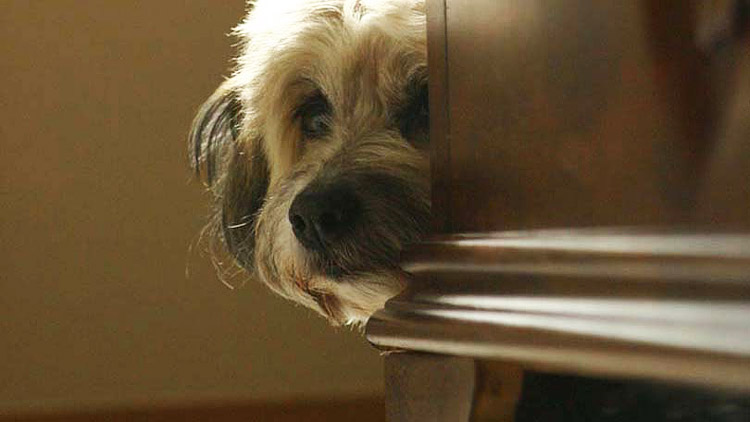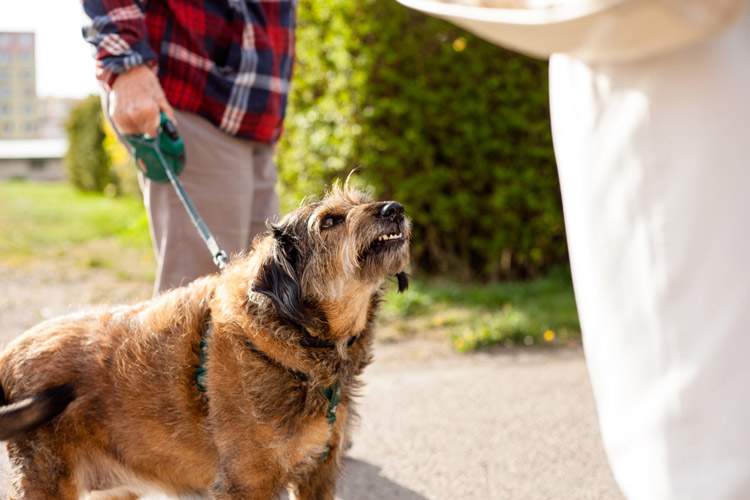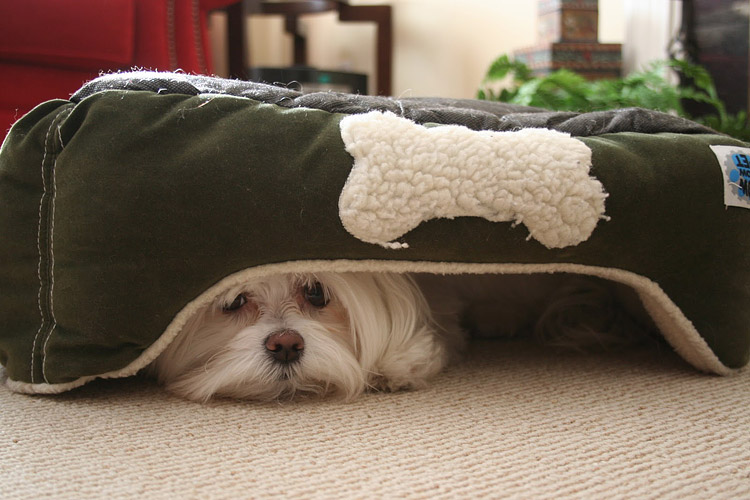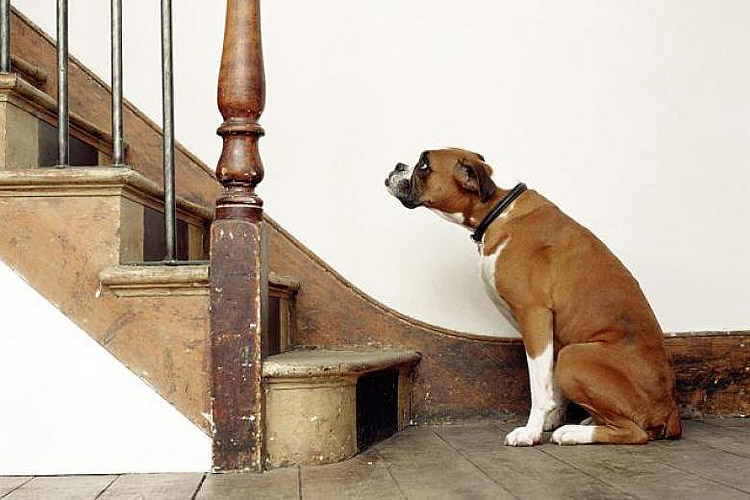
This is common problem: Dogs who are very apprehensive around strangers. Here’s a typical comment from someone seeking her help for this situation:
“My dog seems fine with people. He can walk in crowds and often just ignores guests, but if a stranger tries to reach for and pet him he often backs away and growls. Or at least that’s what he used to do. Now he sometimes barks and occasionally snaps or bites. Why can’t he tell that people are just trying to be friendly?”
Whether thedog is petrified at the vet, skittish around visitors at home, or just dislikes simple care like grooming, there are the ways to help your dog.
Why Fido Snaps at Friendly People

The main problem here usually is that Fido didn’t have enough positive experiences with a variety of unfamiliar people during his sensitive period for socialization and beyond. From three weeks to three months of age,puppies are primed to explore and form bonds. Such that if they meet and greet all types of people in many types of environments and good things happen to them simultaneously, they generalize to understand that people overall are friendly.
Then if this socialization continues through their adolescence, the relaxed demeanor around people becomes part of their overall personality. Those dogs who didn’t get the type and amount of experiences they needed given their individual genetic make-up and early experience can end up being fearful around some or all unfamiliar people.
How People Make the Problem Worse
Of course people inadvertently make the problem much worse. For one, they forget the Golden Rule – ask to pet, first. Instead, well-wishers approach too quickly, crowd too closely or loom over like a thunderstorm ready to dump its load. Under this pressure some dogs will freeze or shrink, pretending it’s all a bad dream. Others take action – usually a reflex bark or low-level growl. A few successes here, and the message is loud and clear: when strangers approach, growl and bark to keep them away. Pretty soon, your sweet, slightly insecure dog has turned into a mass of defensive rumbling.

Some owners respond by reprimanding or punishing their dog. This can teach Fido that he’d better hide his fear from you but it doesn’t make the internal fear disappear. As a result, your dog may no longer show signs that he wants people to back away, instead he holds it in until he can’t take it anymore and then he explodes in a full-blown bite.
Why Do Friendly People Look Scary?
Many humans can’t understand why their dogs would be afraid of them when they’re obviously making friendly human gestures. Turn the tables around and the picture becomes clear. Say you’re afraid of spiders and your friend shoves her pet tarantula in your face. If she simultaneously reassures you, “She’s a friendly tarantula. See her amicable expression?” or “She can’t cause harm, she’s just an innocent baby,” would you suddenly feel safe?
No, in fact the only way you could get used to the spider is if you greeted it at your own pace. That means it would have to be on a table or in some locations where you could control your distance from it. Then when you were ready you could gradually approach for a closer look and to even touch it. The same goes for dogs. All dogs are not outgoing or used to meeting many types of strangers, especially if they were already shy when you adopted them or have received minimal supervised socialization with many types of humans. If you walk into a dog’s personal space or even stand and reach out to let him sniff you hand or to pet him he may feel threatened or be unsure of your intentions. To him, your hand might as well be a meat cleaver.

If however, you stand straight up or crouch down on one knee while looking slightly away, then he can approach and sniff you at his own rate. You can speed up the friendship if you inconspicuously drop tasty treats close to you. If he’s taking these without any hesitation, you can hold treats in your hand while averting your gaze so that shy Fido can choose to take them.
Often people manage to get through the initial greeting with Fido okay but then they make a quick or inappropriate move that scares him into snapping or running away. This is still similar to the situation with the giant spider. Even when you’re finally comfortable enough to examine and touch the tarantula, if it suddenly moves its mouth parts or waves one of its legs in the air you might jump away out of fright. To you these movements may conjure images of the tarantula leaping at you and taking a bite whereas to the tarantula the movements may just be a subconscious change in position or even a signal that it’s your friend. So the trick to ensuring that you don’t frighten Fido even after the initial greeting is to gradually get him used to you in different positions. Avoid learning over him or reaching over his head or grabbing and hugging him so he feels confined. Instead move slowly and smoothly in order to give him a chance to back away.
Read the Dog’s Signals
Probably the biggest issue with these dogs who are uncomfortable with some human greetings is that their humans as well as the unfamiliar greeters fail to recognize the neon sign flashing in the dog’s body postures and movements. It says, “Help! I’m scared. Go Away.” Fido may be tense with eyes darting back and forth or his gaze looking away while he’s cowering. Or he may be yawning, licking his lips or panting when he shouldn’t be hot. Sometimes Fido starts moving in slow motion like he’s sneaking around, or his ears suddenly going out to the sides or back while his brow is furrowed in a worried look. And often his tail is down low, even between his legs. These are all signs of anxiety or fear.
What to Do if You See Signs of Fear

If you see these signs in your dog as someone reaches out to pet him, quickly move away so he’s out of range of the approaching petter. Like the person who’s about to pick up litter but stops because the litter starts to blow away, the signal you send by moving away is to stop. At the same time you can explain “He’s afraid of new people that approach him quickly.” Simultaneously get Fido’s attention on you and reward him for something good such as sitting or looking at you or performing tricks. The goal is to change his emotional state from scared to happy, so that he can eventually learn to associate unfamiliar people with good things. Consequently his fear can go away. Strangers can also toss treats while looking away, but unless you’re absolutely sure that you can tell when Fido is permanently comfortable with them, I’d avoid letting them pet him unless you have a professional coach you through the procedure.
For People Greeting Unfamiliar Dogs
It’s important that you watch body language too. The dog may take treats from you but that doesn’t mean he’s ready to be touched. Watch the response to everything you do because sometimes a split second freeze or lift of the lip is the neon sign that says “That’s too scary for me. Now I’m going to bite.” Instead, just be happy to give treats and admire the dog without touching and know that you’ve given him a good experience.
What Body Language Indicates the Dog is Safe?
The body language you’d like to see when greeting a dog is one that says this whole business is ho-hum. The dog should remain relaxed and his gaze should be steady and soft. His tail should either wag or hang loosely down.
The Solution
If humans would let dogs approach them at their own pace and would even make treats magically appear on the ground around them without pressuring the dog to allowing being petted, they would experience many good dog greetings and help Fido have positive experiences around unfamiliar people, too.





Leave a Reply